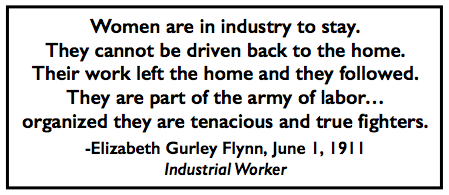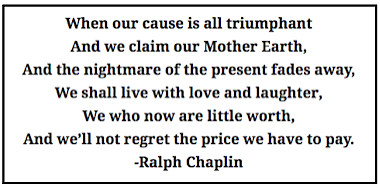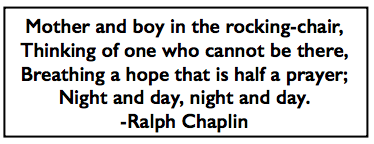 —————
—————
Hellraisers journal – Wednesday September 10, 1913
Profiles of Elizabeth Gurley Flynn, Inez Haynes Gillmore, and Caroline Lowe
From The Progressive Woman of September 1913:
—–
—–
 —————
—————
Hellraisers journal – Wednesday September 10, 1913
Profiles of Elizabeth Gurley Flynn, Inez Haynes Gillmore, and Caroline Lowe
From The Progressive Woman of September 1913:
—–
—–
 ———-
———-
Hellraisers Journal – Sunday September 28, 1919
Chicago, Illinois – Letter from I. W. W. General Defense Committee
From The One Big Union Monthly of September 1919:
 ———-
———-
Hellraisers Journal – Friday September 24, 1909
Farmers Come from Miles Around for Oklahoma Socialists Encampments
From the International Socialist Review of September 1909:
The Oklahoma Encampment
—–
SOCIALIST ENCAMPMENTS. Three meetings a day, five days a week for four weeks, makes a total of sixty red hot propaganda meetings a month, with an attendance of from 500 to 10,000 at each lecture. This is what they are doing at the Oklahoma Socialist Encampment.
Successful encampments have already been held at Waurika, Snyder, Elk City, Aline and Woodward and the country for miles around has been showered with literature. The big canvass tent with a seating capacity of 1,000, is always pitched in a shady, well-watered grove, and from every pole top a red flag floats toward freedom.
Scores of covered wagons file into camp during Monday and far into the night, so that by the time the speaking begins on Tuesday, we find ourselves in the midst of a big, happy and seriously-minded family, happy because they have given the capitalist system the slip for a few days and serious because they realize that they are becoming landless farmers.
 ———-
———-
Hellraisers Journal – Thursday September 11, 1919
I. W. W.’s Languish in Kansas Hell Holes, Part V & VI of Series by W. D. Lane
From The Survey of September 6, 1919:
—–
—–[Parts V & VI of VI.]
V
Several times in this account I have referred to the jails described as having been “chosen” by the United States government for the confinement of prisoners awaiting trial. Let us see what justification there is for the use of this word.
The thirty-four men held under the Wichita indictment were originally taken into custody November 21, 1917. These men were all engaged in the oil industry in Kansas. They were, for the most part, young men, some of them married, some not. Judging from their names-Anderson, Boyd, Gordon, Forbes, Stark, Sapper, Barr, Poe, Gossard, Davis, etc.—many of them were of American or Allied extraction; some foreign names were among them, but only five, so far as I learned, were accused of being enemy aliens. The indictment against them charged violation of the espionage law, the food control law and the selective service law.
On March 10, 1918, a motion to quash this indictment was filed by their attorneys. No ruling on this motion was ever made. The attorneys stood ready, therefore, to go to trial on September 24, the day set. To their surprise, a new indictment was returned on that very day. This was drawn on lines similar to the previous Chicago indictment, which had resulted in sending nearly a hundred I. W. W.’s to prison for terms varying from a few days to twenty years. The attorneys could not at once accept trial on this new indictment, and so they were granted until March 10, 1919, in which to plead.
The men who, in September, had already spent ten months in jail awaiting trial, thus faced another five and a half months of confinement. Miss Lowe, their attorney, undertook to find as comfortable jails as possible, in which, she hoped, they might be allowed to spend the winter. They were then in the Sedgwick county jail, having been transferred to it for the trial. Sheriff Sprout, at Hutchinson, agreed to take twelve of the men, and the sheriff in Winfield, where there was a modern, sanitary jail, agreed to take sixteen. Thinking that she had thus arranged accommodations for twenty-eight, Miss Lowe reported her action to the United States district attorney, Fred Robertson, who was prosecuting the case. Mr. Robertson turned a deaf ear to her plea. In vain did she dwell upon the physical condition of the men and the consequences of spending another five months amid overcrowding and filth. Mr. Robertson said that prisoners had no voice in choosing their places of incarceration, and declared.that he intended to ask Judge John C. Pollock, judge of the United States district court for Kansas, to have all of the men placed in the Wyandotte county jail in Kansas City. This was one of the worst in the state.
 ———-
———-
Hellraisers Journal – Tuesday September 9, 1919
I. W. W.’s Languish in Kansas Hell Holes, Part II of Series by W. D. Lane
From The Survey of September 6, 1919:
—–
—–[Part II of VI.]
II
To begin with the Shawnee county jail at the state capital of Kansas, Topeka. Ten members of the I. W. W. were confined there at the time of my visit. These were held under what has come to be known as the Wichita indictment. Their original arrest had occurred in November, 1917, so that they had been continuously confined in one jail or another for a year and two months. All of this time they were awaiting trial.
The Shawnee jail is a typical county lock-up in structure. Its outer walls are of brick. Men are confined in a sort of room within a room, formed by constructing a rectangular stockade inside the brick walls. The walls of this stockade are of steel lattice work, the bars of the lattice being about two inches wide and the holes about two inches square. It is through these holes that light and air enter. The cells are built in two facing rows inside the stockade. Their rear walls are the walls of the stockade itself and they open toward its center. In length the stockade is about thirty-five feet, in width twenty-six.
There are five cells in each row. Each cell is seven feet wide, seven feet long and seven feet high. Ordinarily two men are placed in each of these, but when the jail is crowded additional bunks are slung from the sides and four men sleep in this space. The central part of the stockade, that not occupied by cells, is thirty-five feet long and twelve feet wide. This is the prisoners’ livingroom, the only area besides their cells to which they have access. Light enters the jail proper through windows in the outer brick walls. These windows are frosted. The light must, therefore, pass through these frosted windows, through the steel lattice work and travel the length of the cells before it reaches this inner space. The result is that no daylight ever reaches this part of the stockade. The sun was shining brightly on the day of my visit, but its rays did not penetrate to this central area. A single electric bulb burned in the ceiling and shed a ghostly glimmer over the faces of the men; this bulb is kept lighted day and night. It was possible to read in only three of the cells and then only by standing close to the latticework. On cloudy days the men light candles.
 ———-
———-
Hellraisers Journal – Monday July 12, 1909
Mother Jones News Round-Up for June 1909, Part I:
-Meets with President Taft on Behalf of Mexican Refugees
From Oakland Tribune of June 24, 1909:
 ———-
———-
Hellraisers Journal – Wednesday May 14, 1919
Upton Sinclair Exposes the Barbaric Sedgwick County Jail
From the Appeal to Reason of May 10, 1919:
Hell Holes in America
In the Amnesty Edition of the Appeal I reproduced a circular sent out by the I. W. W. boys, describing the terrible conditions in the Sedgwick county jail at Wichita, Kans. I made no investigation of their statements, but acted on my general impulse to believe the worst about American jails. Those which I have investigated in past times have disposed me to believe that nobody could possibly exaggerate their evils. But soon after this article appeared in the Appeal I received letters from several correspondents who reported that they had complained to the Governor of Kansas about the matter, and had received from him a report of a confidential investigation which he had had made into this Wichita jail. The report stated that conditions in the jail were excellent, and that all the accounts sent out by the I. W. W. were false.
Now the Governor of Kansas, Henry J. Allen, is a progressive politician and a gentle man. I feel acquainted with him from reading “The Martial Adventures of Henry and Me,” by William Allen White-Governor Allen being the Henry” of that book. So I began to feel real bad about what I had published, and made ready to apologize to Governor Allen, and also to the readers of the Appeal for the blunder I had made.
But I studied that report again and noted that the Governor’s investigator denied that the I. W. W. boys had been arrested for trying to call a strike of the oil workers. He said they had been arrested for hindering the prosecution of the war. I have encountered that official bunk so often that I know the type of mind that swallows it.
And then I recalled the many, many times in my life when I had followed the work of official investigators, in cases with which I myself was entirely familiar. I recalled, for example the statement given out about the county jail here in Los Angeles, that the prisoners had had lice brought in and put them on their bodies prior to my inspection! I recalled Major Louis L. Seaman of the United States army, who investigated the Chicago stockyards for Collier’s Weekly, at the time when the Appeal to Reason was publishing “The Jungle.” Major Seaman was a gentleman of undoubted integrity, and he reported that everything was lovely in that inferno of graft. You see, these gentlemen of undoubted integrity have their class point of view, and they let themselves be escorted around, and they only see what they are shown-and even then, most of the time they don’t realize what they are seeing!
So I decided that before I apologized to Governor Allen, I would inquire a little farther. I wrote to Caroline Lowe, a woman who has interested herself in the defense of political prisoners, and asked if she happened to know anything about this particular jail. In reply came a letter which speaks for itself and which I quote:
Regardless of any denial made by the Governor of the State of Kansas, I can testify of my own knowledge that the conditions not only in the Wichita jail but in the jail at the State capitol at Topeka, Kans., beggar description. The rotary tank in the jail at Wichita is a relic of barbarism. I have been in the jail many times and have seen this tank in operation.
 ———-
———-
Hellraisers Journal – Tuesday February 25, 1919
Ellis Island – FWs, Deported on “Red Special,” Held Incommunicado
From The Survey of February 22, 1919:
The Deportations
[Part II]
Who are the fifty-three men and one woman who reached New York city last week? It is difficult to tell, since they have been held incommunicado at Ellis Island since their ar rival on February 11 to noon of February 17, when this issue of the Survey went to press. All requests of friends, attorneys and representatives of the press to see them have been denied. A list giving their names, date of conviction and the reasons for deportation of each was, however, supplied to the press by Byron H. Uhl, acting commissioner of immigration at New York in the absence of Frederic C. Howe, who is in Europe.
According to this list, eleven have been found to be “members of or affiliated with an organization that advocates or teaches the unlawful destruction of property.” Eighteen were found actually “advocating or teaching the unlawful destruction of property.” Some of these are declared, also, to have been guilty of other offenses, such as advocating “the overthrow by force or violence of the government of the United States or of all forms of law.” Three are declared to be anarchists or to have taught anarchy. The remainder are charged with various offenses, most of them with being “likely to become public charges.” Several are said to be “morally unfit,” a few served prison terms before coming to this country, and one or two committed “crimes involving moral turpitude” within five years after entering.

Hellraisers Journal – Thursday January 16, 1919
Leavenworth Penitentiary – Report on Brutal Treatment of Prisoners, Part II
From The New Appeal of January 11, 1919:
[Part 2 of 2.]
Summing up the results of his inquiry, Mr. Moore [Attorney for the Industrial Workers of the World] says:
Extremely fragmentary as is the above, I believe that the following points may be considered as fully established:
1. That negro convicts armed with clubs were used under the direction of Mr. Fletcher [Deputy Warden] to beat up white men. That among those so beaten up were Stratton, Murphy and Floyd Ramp.
2. That many prisoners, whose physical condition was extremely bad, were placed on bread and water diet and deprived of their blankets and compelled to sleep on the cement floor at a time when this would seriously endanger their health.
3. That many prisoners were chained by their wrists to the sides of their cells and so compelled to stand for a period in excess of twenty-four hours.
Visits Husband in Cell.
In an affidavit, of which The New Appeal has been furnished a copy, Mrs. Floyd Ramp, wife of one of the solitary prisoners, states that she was allowed a brief visit with her husband on December 15, having come to Leavenworth in response to a report from friends that her husband had been seriously injured. Mrs. Ramp states that she was not permitted to question her husband regarding his injuries, but that his right eye was badly discolored and he was in an emaciated condition. Owing to the presence of the guard she could elicit no information of what had occurred beyond the most vague and unsatisfactory references. Ramp did say that Stratton was “pretty badly hurt.” Mrs. Ramp states “that Jack Phelan, who was released from the Leavenworth prison on December 18 because declared by the Appellate Court to have been illegally incarcerated on a charge of violating the Espionage Act, told her he had seen Floyd Ramp’s body and that it was a mass of bruises which led him to believe that he had been beaten, kicked and trampled upon.”

Hellraisers Journal – Wednesday January 15, 1919
Leavenworth Penitentiary, Kansas – Brutal Treatment of Prisoners Reported
From The New Appeal of January 11, 1919:
[Part 1 of 2.]
In its issue of last week The New Appeal reproduced a report of conscientious objectors at Camp Funston, Kans., detailing the brutal treatment to which they were subjected at the command of certain officers, contrary to the express directions of the war department in Washington. This report was published primarily as a matter of record, the guilty officers having been dismissed from the service and the conditions complained of corrected.
We are now in the way of making a more important exposure-an exposure of brutalities committed upon Socialists, I. W. W.s. and others imprisoned in the Federal penitentiary at Fort Leavenworth, Kans., brutalities that we have reason to believe have not been brought to the notice of the higher authorities since the efforts of interested persons to investigate these brutalities have been baffled at every turn by prison officials. Enough evidence has been dragged into the light, however, to make it shamefully plain, to use the words of Mrs. Floyd Ramp, wife of a Socialist prisoner, “that things are occurring in this penitentiary which citizens of a democracy should not knowingly countenance.”
Could Not Question Prisoners.
On December 12, F. H. Moore, a Chicago attorney, went to Leavenworth to discuss certain legal steps with the group of prisoners sentenced under the Chicago indictment of the I. W. W. alleged anti-war agitators. He also desired to make personal inquiry of the treatment the prisoners were receiving, disquieting reports of which had reached him through “underground” channels. In company with Miss Caroline A. Lowe, who assisted in the defense of the prisoners at the trial, Mr. Moore called upon the warden. They were told by the warden that they could talk over legal matters connected with the case, but they were absolutely forbidden to question the prisoners as to conditions in the penitentiary.
Mr. Moore, in a somewhat lengthy communication sent to The New Appeal, repeatedly emphasizes this autocratic censorship of the warden. As they interviewed, separately, each one of twenty-two prisoners held in solitary confinement with unusual punishment, the deputy warden, who was present during the interviews, sternly suppressed every attempt to question the prisoners as to the manner in which they had been handled and as to their physical condition at the time. Nor were Mr. Moore and Miss Lowe, when they met and conferred with the majority of the prisoners in a body permitted to refer to the condition of their fellow prisoners who were “in solitary.”